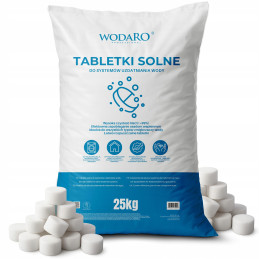- There are no more items in your cart
- Shipping
- Total zł0.00
- Bestsellers
- Hurt
- Water filters
- Whole house filters
- Kitchen filters
- Bathroom filters
- Aquarium filters
- Reverse osmosis
- Water demineralizers
- Filter cartridges
- UV bactericidal lamps
- Alkaline water ionizers
- Industrial water filters
- Accessories, parts, and others
- Descaling filters for the coffee machine
- Water softeners and iron removers
- Water saturators
- ACES
- AMBERLITE
- AQUA VITA
- AQUAFILTER
- AQUAPHOR
- AQUATOR
- BASSAU
- BERG
- BIOCERA
- BIONIQ
- BLUEFILTERS
- CHEMOFORM
- CINTROPUR
- DAFI
- DELONGHI
- DIAMOND
- DOM WODY
- ECOWATER
- FILMTEC
- FIT ALCO
- FITAQUA
- GREEN FILTER
- HANNA INSTRUMENTS
- HELIXPRO
- HELLO PURE
- HIDROTEK
- HM-DIGITAL
- HONEYWELL
- JAVEL
- KLARWOD
- KRUPS
- MIDEA
- OTOWODA
- OTTONE
- Palintest
- PENTAIR
- PHILIPS
- PLATINUM WASSER
- PUROLITE
- SIEMENS
- SUPREME
- TAB-SOL
- TOP FILTER
- UST-M
- USTM
- VONTRON
- WODARO
Porady
Salt for Water Softener - A Comprehensive Guide to Tablet Salts
Salt for water softeners is an essential component of water softening systems designed to eliminate hard minerals such as calcium and magnesium. In this guide, you will find detailed information about different types of salt, their applications, as well as answers to frequently asked questions regarding their use.
Filtruj
Types of salt used in water softeners
Tablet salt for water softeners - selection and application
Tablet salt is easy to use and effectively regenerates ion exchange resin. It is available in large bags, such as 25kg salt for softeners, which is an economical choice for residential, industrial, and commercial users.
Pellet salt for softeners - characteristics and effectiveness
Pellet salt is very similar to tablet salt, but may differ slightly in shape and size. It is also a popular option among water softener users.
How does salt work in the water softening process?
Regeneration process
The regeneration of ion exchange resin in a water softener is a key stage that ensures the continuous effectiveness of water softening. Here’s how the process works using salt:
-
Preparation of brine solution: In the softener tank, salt, usually in tablet form, dissolves in water to create brine.
-
Flow of brine through the resin: The brine solution is pumped through the ion exchange resin, where sodium ions from the brine exchange places with calcium and magnesium ions that the resin has retained.
-
Ion exchange: Calcium and magnesium ions are washed out of the resin by sodium ions, which “cleans” the resin and restores its ability to soften water.
-
Emptying the tank: After the ion exchange is complete, the excess brine along with the washed-out calcium and magnesium ions is removed from the resin.
-
Resetting the resin: After washing out the excess brine, the resin is ready for further water softening.
Clumped salt in the softener – causes and prevention
Clumped salt in the softener can hinder the proper functioning of the system. To prevent clumping, salt should be stored in a dry place and the softener tank should be regularly checked and cleaned.
How much salt for the softener?
It is recommended to maintain the salt level at about two-thirds of the tank, adding salt when the level drops below one-quarter of its height. On average, in typical household conditions, this may mean needing to replenish about 25 kg of salt every three months.
How to add salt to the water softener?
-
Check the salt level: Regularly check the salt level in the softener tank. The optimal salt level should reach from one-third to half of the tank.
-
Open the salt tank: Remove the lid of the salt tank in the softener.
-
Remove clumped salt: If you notice that the salt has clumped at the bottom of the tank, gently break it up using an appropriate tool, such as a wooden scoop.
-
Add salt: Using a clean container, pour salt into the tank, trying to distribute it evenly across the entire surface. Ensure that the salt does not block the water inlet.
-
Close the tank: After adding the appropriate amount of salt, close the softener tank.
Should the salt in the softener be submerged in water?
The salt in the water softener tank should not be completely submerged in water. It is recommended that the water only covers the bottom of the tank. This ensures that the brine solution, which is needed for resin regeneration, is adequately concentrated and effective. Excess water can dilute the brine, reducing regeneration efficiency.
How often should salt be added to the softener?
The frequency of adding salt tablets depends on many factors, including water hardness, the amount of water used, and the capacity of the softener. Salt tablets should be added at least once a month.
Is salt for the softener healthy?
The salt used in water softeners does not directly enter drinking water, which means it does not affect users' health. Tablet salt is used to regenerate ion exchange resin, which removes water hardness, and clean, soft water is beneficial for health as it reduces the risk of scale buildup and improves the performance of water-using appliances. The use of salt tablets for water softening contributes to reducing the need for dishwashing detergents, which is an additional benefit for health and the environment.
What can be used instead of salt for the softener?
Although salt is the standard agent used for regenerating water softeners, there are alternative methods that can be used in some specific cases. Some modern systems may use potassium instead of sodium salt, which is particularly beneficial in areas where there are restrictions on sodium content in the environment. Potassium is more environmentally friendly but also more expensive compared to traditional softener salt.
What is the best salt for water softeners?
Vacuum salt for water softeners in 25kg packaging
This is a high-quality product that stands out from the salts available in supermarkets. It is specially adapted for use in softeners, minimizing the risk of clumping and clogging. Water treated with these high-quality salt tablets is completely safe for use.
Advantages of vacuum salt tablets
No clumping: Due to their quality, vacuum salt tablets minimize the risk of clumping, which is a common problem with lower quality supermarket salts. Clumping of salt can lead to ineffective resin regeneration and increased salt consumption.
Protection of softener components: Vacuum salt does not clog softener components such as valves, filters, or pump systems. This is important as clogs can lead to costly repairs and part replacements. They do not contain mechanical impurities.

Summary
Salt for water softeners plays a crucial role in maintaining the efficiency of water softening systems. Regular monitoring of salt levels, proper addition, and the use of high-quality salt tablets are key to the long-term performance and reliability of the softener.
With proper maintenance and care of the softening system, users can enjoy soft, clean water that contributes to improving quality of life and protecting plumbing systems from damage caused by hard water. High-quality salt tablets are essential for the effective operation of water treatment stations.




